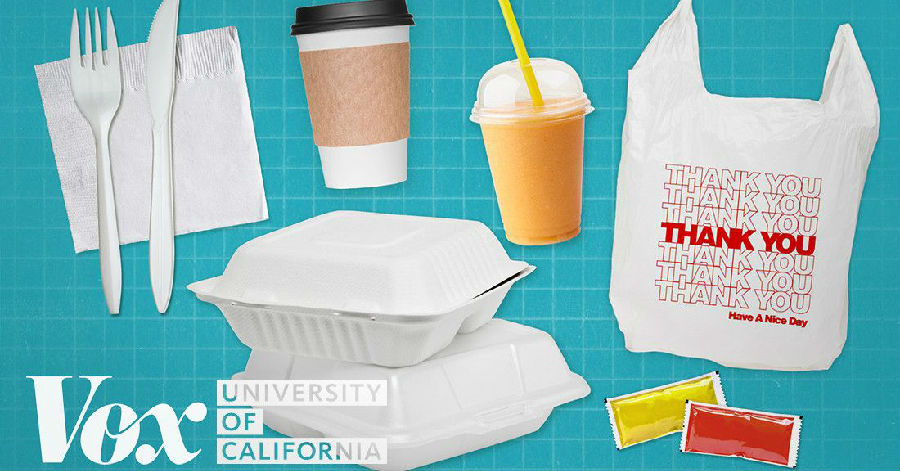Who doesn’t love takeout food? It’s convenient. Easy.
外卖谁不喜欢呢?又方便,又省事。
Most of the time, it’s delicious.
大多数时候,味道也都不错。
But with every order, there’s just a lot of stuff that comes with the meal.
只是,每一单外卖,都会附带很多的东西。
Look, here’s what I got when I ordered Thai.
看,这是我点泰国菜的东西。
This is from my breakfast this morning.
这是我今天的早餐。
And this is all the stuff you get with one of those meal delivery kits.
这些全部都是外卖餐包附带的东西。
Some of it, you can recycle.
有一部分是可以回收的。
Some of it, it’s compostable.
有些是可以分解的。
But a lot of it…well, I really don’t know.
但还有很多…呃,真的母鸡啊。
And all this waste — it isn’t just a problem that we can solve with recycling alone.
外卖产生的所有这些垃圾,并不是光靠回收就能解决的。
These little containers and wrappers may not seem like a big deal,
这些盒子啊包装纸啊,看着好像并不是什么大问题,
but in the U.S., packaging makes up the largest category of municipal waste.
但在美国,包装垃圾其实是城市垃圾最大的一个类别。
On top of that, single-use items make up another 10 percent of all our discards.
除此之外,我们的废弃物中有10%都是一次性物品。
And this kind of mindless consumption has a really big impact on climate change.
而这种盲目的消费对气候变化其实是有很大影响的。
Roughly 29 percent of our nation’s greenhouse gas emissions come from the way we make, consume, and dispose of stuff.
我们国家排放的温室气体有将近29%的都来源于我们制造、消费和处理物品方式的问题。
That’s more than the emissions that come from heating our homes or driving around in our cars.
比家庭取暖或开车所产生的温室气体都多。
It takes a lot of energy and resources to produce single use items —
生产这些一次性物品也需要耗费大量的人力以及资源——
these things we use only for a few minutes or even a few seconds before they become trash.
但这些东西我们只用几分钟甚至几秒钟就变成了垃圾。
And when single-use items go into a landfill, all that paper and plastic is destroyed —
这些一次性物品被送到填埋场以后,所有那些纸啊塑料啊都会被毁坏——
and so we have to go out there and extract new raw materials to replace it.
这样一来,我们便不得不重新提取新的原材料来代替它们。
"We really do need to prioritize reduce and reuse over recycling.
“我们真的需要把减少利用和再利用放到回收利用之上。
Recycling is great to deal with the product once it’s already in your hand.
如果产品已经到你手上了,回收也是一个很好的处理办法。
You’ve got to make a good decision on where it goes, but waste minimization is more important."
你得慎重决定它的去向,但最大程度地减少浪费比回收更重要。”
This is Anne Krieghoff — she’s the recycling manager at the University of California, Irvine.
这位是Anne Krieghoff,她是加州大学欧文分校的回收经理。
Her goal is to get the campus to zero waste.
她的目标是让该校实现零浪费。
And there’s some super simple ways that we can reduce a lot of this single-use trash.
其实,一些超级简单的办法就能帮助我们减少这种一次性垃圾。
Look, have you ever ordered a burger and fries and inside the bag,
话说,你是否也有过这样的经历,点了一袋子汉堡和薯条,
there are like, a thousand packets of ketchup that you really aren’t going to use?
然后商家给了你超多番茄酱,你根本就用不完?
They may look innocent, but there’s really no way to recycle them.
听上去好像是人畜无害的东西,但其实真的完全没办法回收。
So, one of the easiest ways to eliminate this trash is to serve condiments in bulk.
所以,要清除这些垃圾,最简单的方法就是按瓶卖。
"Remember the way you used to get a hot dog at the baseball game,
还记得以前看棒球赛的时候你怎么买热狗吗?
you’d go up to the pump and get your ketchup and your mustard.
那个时候番茄酱和芥末都得你自己去打。
That is the best way."
那就是最好的方法。

Think how much you could save with one bulk ketchup dispenser.
想想看,你用一个散装瓶能省下多少番茄酱。
Or bulk sugar at the coffee shop.
省下多少咖啡店赠送的糖包。
Another way to reduce trash is to just stop overpackaging things.
另一个减少垃圾的办法是停止过度包装。
Now, here’s a classic example.
下面就是典型的过度包装的例子。
Look, this is how I got my lunch today.
这是我今天点的午餐。
So it’s a plastic bag and inside it is a paper bag. I mean, what’s the purpose of this?
外面是一个塑料袋,里面还有一个纸袋。我想说,何必呢?
You know, maybe I could have actually just carried this out without a bag.
其实,不用袋子就这么拿走也行啊。
Or simply put it in my backpack.
包装成这样我就能直接放背包了。
"It would be great if companies started saying, 'We’re not serving the plastic bag unless you ask for it.'
要是店家说,‘我们不提供塑料袋,除非你主动索要。’就好了。
Don’t offer it — just wait if somebody needs that."
不要主动提供——就等着,等顾客自己找你要。”
And that’s really the key.
这才是关键。
See, a lot of useless trash is created because companies just kind of hand it to us, assuming that we want it.
看,很多无用的垃圾被这么被制造出来了,商家以为我们想要他们给包装成这样,他们就这么把这些东西交到了我们手上。
But a lot of times we don’t.
但很多时候我们并不想要这么繁杂的包装。
This is something that Seamless and Grubhub, the food delivery apps, are trying to take on.
这恰好也是Seamless和Grubhub这两个外卖app正在努力的方向。
When you place an order on their website,
你在他们的网站上下单的时候,
they give you the option to skip the utensils and napkins,
他们会提供跳过餐具和餐巾的选项,
which you probably don’t need if they’re actually coming to your home or to your office.
因为如果你是在家里或是在公司用餐的话,可能会不需要。
In 2013 alone, Seamless reported that they saved more than a million sets of plastic utensils and napkins — all with a simple check box.
仅2013年一年,Seamless报告称,他们就节省了100多万套塑料餐具和餐巾纸——就只用了一个简单的复选框就做到了。
Just having the option to say no makes it way easier for customers to reduce their trash.
就一个说“不”的机会,对消费者而言,就让减少垃圾的工作变得轻松多了。
And saving those forks and napkins helps restaurants as well,
省下那些餐叉和纸巾其实对餐厅也有好处,
since ultimately they’re the ones who are paying for them.
因为说到底,花钱买那些东西的是他们。












